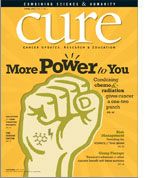Publication
Article
CURE
Sarcoma in the Young
Author(s):
Sarcoma is more common in children and young adults.
Sarcomas represent a higher percentage of cancer in children and young adults than adults, accounting for approximately 15 percent of all pediatric cancers. Most common in children are rhabdomyosarcoma, a type of soft tissue sarcoma (STS), and the bone cancers Ewing’s sarcoma and osteosarcoma.
For 25-year-old Jessica Bongiovanni, the path to a diagnosis of bone sarcoma started as it does for most—with unexplained pain. A former college athlete, Bongiovanni was no stranger to sports injuries, and she blamed shin splints for the pain in her right knee that developed in early 2012. But a lump later appeared, and a magnetic resonance imaging (MRI) scan revealed a mass in her leg that was diagnosed as osteosarcoma. Bongiovanni’s tumor was aggressive and chemotherapyresistant, and her only hope for a cure was amputation. She took the news with admirable pragmatism. “If the only way for me to be cured is for you to take my leg, then you don’t have to convince me,” she recalled saying. Bongiovanni recently had lung surgery to remove two small masses that showed up in a follow-up scan. The masses were benign, but sadly, Bongiovanni died as a result of complications from the surgery, only five days after being declared cancer-free.
Fertility preservation is an important issue in pediatric sarcomas.
“Amputation is a very unusual thing,” says Paul Meyers, vice-chairman of pediatric oncology at Memorial Sloan-Kettering Cancer Center in New York, who treated Bongiovanni. And even when required, it’s not necessarily the worst outcome. Optimal limb function is the top priority, says Meyers, “and you don’t play baseball with a piece of metal replacing the bone because it’s too fragile.”
Fertility preservation is an important issue in pediatric sarcomas, as many patients are in or nearing their peak fertility years when they receive their diagnosis, and many chemotherapy drugs can compromise fertility. As a result, Meyers’ patients are offered fertility-preserving procedures prior to chemotherapy. Bongiovanni opted not to freeze her eggs, a process that is substantially more costly, invasive and time-consuming compared to sperm preservation for males.
Although the overall cure rate for children and young adults with sarcoma is 60 to 70 percent, new options are needed for those with metastatic disease, of whom only 10 to 30 percent survive more than five years after diagnosis. Several targeted drugs have shown promise and are being tested in ongoing clinical trials. For rhabdomyosarcoma and Ewing’s sarcoma, these include cixutumumab, figitumumab, sirolimus and everolimus. Osteosarcomas might express certain growth receptors that are targets for the drugs Gleevec (imatinib) and Avastin (bevacizumab). Some evidence suggests that osteosarcomas also express the breast cancer-associated growth factor receptor HER2, which is blocked by the highly successful drug Herceptin (trastuzumab).






